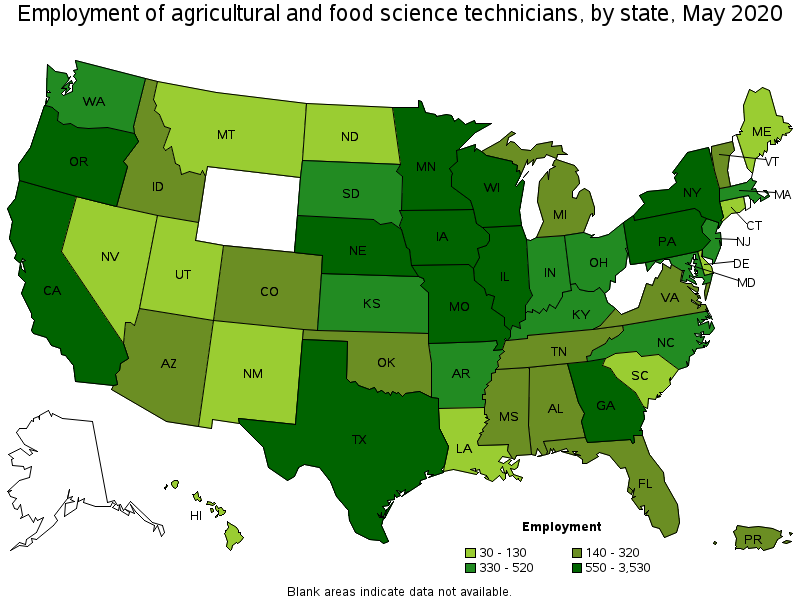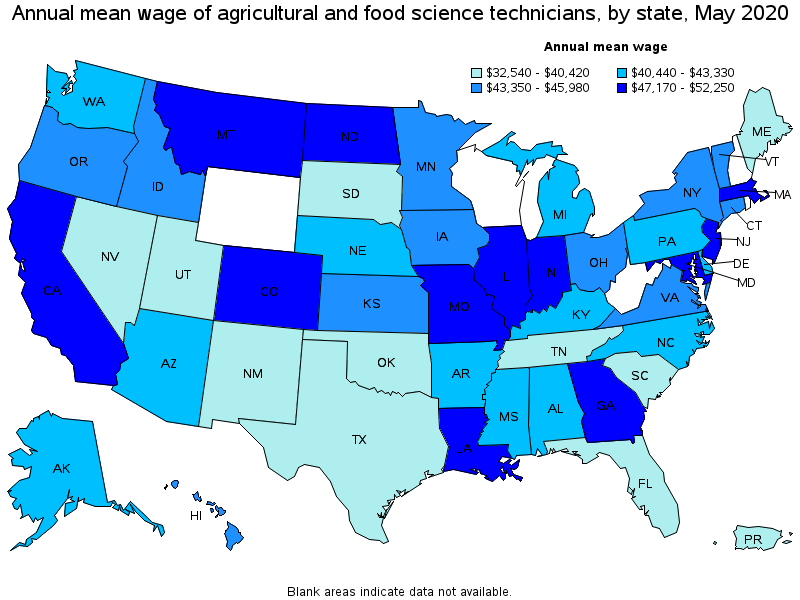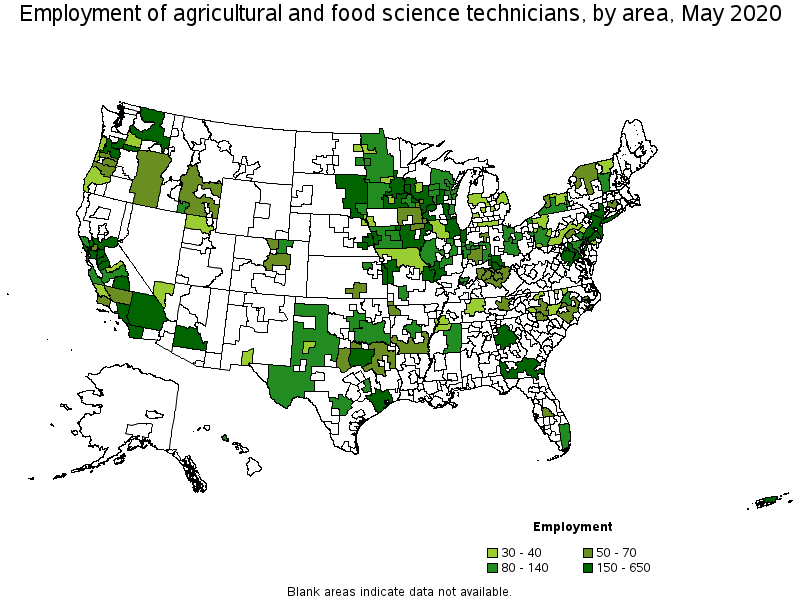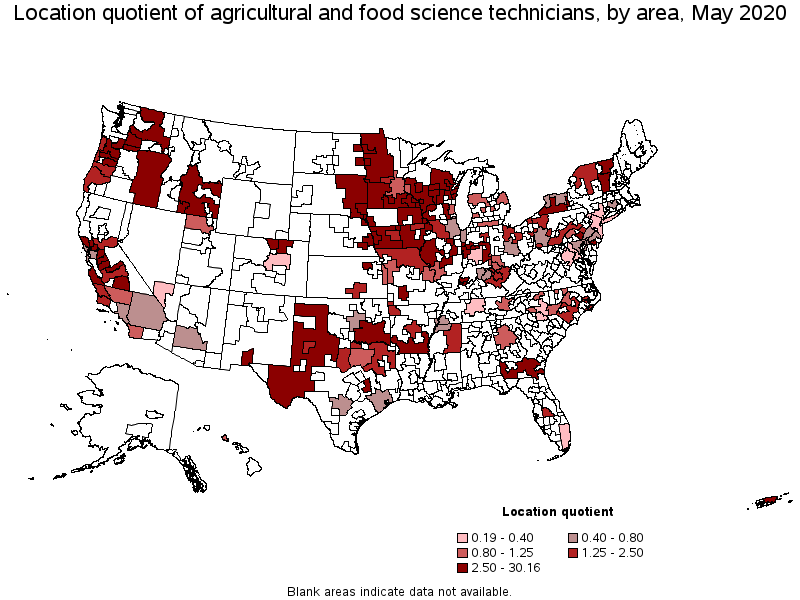An official website of the United States government
 United States Department of Labor
United States Department of Labor
This occupation includes the 2018 SOC occupations 19-4012 Agricultural Technicians and 19-4013 Food Science Technicians and the 2010 SOC occupation 19-4011 Agricultural and Food Science Technicians.
Employment estimate and mean wage estimates for Agricultural and Food Science Technicians:
| Employment (1) | Employment RSE (3) |
Mean hourly wage |
Mean annual wage (2) |
Wage RSE (3) |
|---|---|---|---|---|
| 21,940 | 3.2 % | $ 22.08 | $ 45,920 | 1.5 % |
Percentile wage estimates for Agricultural and Food Science Technicians:
| Percentile | 10% | 25% | 50% (Median) |
75% | 90% |
|---|---|---|---|---|---|
| Hourly Wage | $ 13.77 | $ 16.61 | $ 20.18 | $ 25.60 | $ 32.03 |
| Annual Wage (2) | $ 28,650 | $ 34,550 | $ 41,970 | $ 53,250 | $ 66,620 |
Industries with the highest published employment and wages for Agricultural and Food Science Technicians are provided. For a list of all industries with employment in Agricultural and Food Science Technicians, see the Create Customized Tables function.
Industries with the highest levels of employment in Agricultural and Food Science Technicians:
| Industry | Employment (1) | Percent of industry employment | Hourly mean wage | Annual mean wage (2) |
|---|---|---|---|---|
| Colleges, Universities, and Professional Schools | 2,950 | 0.10 | $ 20.43 | $ 42,490 |
| Dairy Product Manufacturing | 2,390 | 1.59 | $ 21.82 | $ 45,390 |
| Scientific Research and Development Services | 2,370 | 0.31 | $ 21.82 | $ 45,380 |
| Grain and Oilseed Milling | 1,310 | 2.12 | $ 23.05 | $ 47,940 |
| Other Food Manufacturing | 1,160 | 0.51 | $ 23.24 | $ 48,330 |
Industries with the highest concentration of employment in Agricultural and Food Science Technicians:
| Industry | Employment (1) | Percent of industry employment | Hourly mean wage | Annual mean wage (2) |
|---|---|---|---|---|
| Grain and Oilseed Milling | 1,310 | 2.12 | $ 23.05 | $ 47,940 |
| Dairy Product Manufacturing | 2,390 | 1.59 | $ 21.82 | $ 45,390 |
| Animal Food Manufacturing | 420 | 0.65 | $ 21.97 | $ 45,700 |
| Fruit and Vegetable Preserving and Specialty Food Manufacturing | 1,040 | 0.63 | $ 21.34 | $ 44,380 |
| Other Food Manufacturing | 1,160 | 0.51 | $ 23.24 | $ 48,330 |
Top paying industries for Agricultural and Food Science Technicians:
| Industry | Employment (1) | Percent of industry employment | Hourly mean wage | Annual mean wage (2) |
|---|---|---|---|---|
| Merchant Wholesalers, Nondurable Goods (4241, 4247, and 4249 only) | 420 | 0.08 | $ 27.59 | $ 57,400 |
| Management of Companies and Enterprises | 680 | 0.03 | $ 26.25 | $ 54,590 |
| Wholesale Electronic Markets and Agents and Brokers | 200 | 0.04 | $ 24.56 | $ 51,080 |
| Merchant Wholesalers, Nondurable Goods (4242 and 4246 only) | 40 | 0.01 | $ 24.28 | $ 50,510 |
| Management, Scientific, and Technical Consulting Services | 960 | 0.06 | $ 24.08 | $ 50,080 |
States and areas with the highest published employment, location quotients, and wages for Agricultural and Food Science Technicians are provided. For a list of all areas with employment in Agricultural and Food Science Technicians, see the Create Customized Tables function.

States with the highest employment level in Agricultural and Food Science Technicians:
| State | Employment (1) | Employment per thousand jobs | Location quotient (9) | Hourly mean wage | Annual mean wage (2) |
|---|---|---|---|---|---|
| California | 3,530 | 0.22 | 1.36 | $ 24.38 | $ 50,710 |
| Wisconsin | 1,580 | 0.58 | 3.70 | (8) | (8) |
| Texas | 1,420 | 0.12 | 0.74 | $ 19.43 | $ 40,420 |
| Georgia | 1,080 | 0.25 | 1.59 | $ 22.73 | $ 47,280 |
| Illinois | 1,000 | 0.18 | 1.13 | $ 22.68 | $ 47,170 |

States with the highest concentration of jobs and location quotients in Agricultural and Food Science Technicians:
| State | Employment (1) | Employment per thousand jobs | Location quotient (9) | Hourly mean wage | Annual mean wage (2) |
|---|---|---|---|---|---|
| Nebraska | 940 | 1.00 | 6.33 | $ 19.86 | $ 41,300 |
| South Dakota | 340 | 0.83 | 5.29 | $ 15.64 | $ 32,540 |
| Iowa | 930 | 0.64 | 4.03 | $ 21.55 | $ 44,830 |
| Wisconsin | 1,580 | 0.58 | 3.70 | (8) | (8) |
| Vermont | 160 | 0.58 | 3.69 | $ 21.21 | $ 44,110 |

Top paying states for Agricultural and Food Science Technicians:
| State | Employment (1) | Employment per thousand jobs | Location quotient (9) | Hourly mean wage | Annual mean wage (2) |
|---|---|---|---|---|---|
| Massachusetts | 330 | 0.10 | 0.63 | $ 25.12 | $ 52,250 |
| New Jersey | 510 | 0.14 | 0.86 | $ 25.12 | $ 52,240 |
| California | 3,530 | 0.22 | 1.36 | $ 24.38 | $ 50,710 |
| North Dakota | 130 | 0.31 | 1.99 | $ 23.66 | $ 49,220 |
| Colorado | 250 | 0.10 | 0.62 | $ 23.53 | $ 48,930 |

Metropolitan areas with the highest employment level in Agricultural and Food Science Technicians:
| Metropolitan area | Employment (1) | Employment per thousand jobs | Location quotient (9) | Hourly mean wage | Annual mean wage (2) |
|---|---|---|---|---|---|
| Los Angeles-Long Beach-Anaheim, CA | 650 | 0.11 | 0.71 | $ 24.35 | $ 50,650 |
| Portland-Vancouver-Hillsboro, OR-WA | 500 | 0.44 | 2.76 | $ 20.61 | $ 42,880 |
| Chicago-Naperville-Elgin, IL-IN-WI | 480 | 0.11 | 0.69 | $ 25.10 | $ 52,210 |
| Dallas-Fort Worth-Arlington, TX | 470 | 0.13 | 0.83 | $ 21.80 | $ 45,350 |
| New York-Newark-Jersey City, NY-NJ-PA | 380 | 0.04 | 0.27 | $ 24.05 | $ 50,020 |
| Atlanta-Sandy Springs-Roswell, GA | 370 | 0.14 | 0.90 | $ 24.18 | $ 50,300 |
| Sacramento--Roseville--Arden-Arcade, CA | 360 | 0.38 | 2.38 | $ 28.88 | $ 60,070 |
| Lincoln, NE | 330 | 1.87 | 11.88 | $ 19.10 | $ 39,720 |
| Philadelphia-Camden-Wilmington, PA-NJ-DE-MD | 280 | 0.11 | 0.67 | $ 24.47 | $ 50,900 |
| Houston-The Woodlands-Sugar Land, TX | 280 | 0.09 | 0.60 | $ 19.91 | $ 41,400 |

Metropolitan areas with the highest concentration of jobs and location quotients in Agricultural and Food Science Technicians:
| Metropolitan area | Employment (1) | Employment per thousand jobs | Location quotient (9) | Hourly mean wage | Annual mean wage (2) |
|---|---|---|---|---|---|
| Ames, IA | 210 | 4.76 | 30.16 | $ 20.58 | $ 42,810 |
| Manhattan, KS | 130 | 3.59 | 22.77 | $ 17.68 | $ 36,770 |
| Napa, CA | 170 | 2.39 | 15.18 | $ 22.96 | $ 47,750 |
| Merced, CA | 150 | 2.03 | 12.89 | $ 25.47 | $ 52,970 |
| Lincoln, NE | 330 | 1.87 | 11.88 | $ 19.10 | $ 39,720 |
| Twin Falls, ID | 80 | 1.77 | 11.25 | $ 17.52 | $ 36,440 |
| Lafayette-West Lafayette, IN | 140 | 1.60 | 10.13 | $ 24.89 | $ 51,760 |
| Visalia-Porterville, CA | 220 | 1.48 | 9.36 | $ 21.56 | $ 44,840 |
| Wausau, WI | 100 | 1.46 | 9.24 | $ 19.28 | $ 40,100 |
| Modesto, CA | 240 | 1.34 | 8.51 | $ 19.21 | $ 39,950 |

Top paying metropolitan areas for Agricultural and Food Science Technicians:
| Metropolitan area | Employment (1) | Employment per thousand jobs | Location quotient (9) | Hourly mean wage | Annual mean wage (2) |
|---|---|---|---|---|---|
| Sacramento--Roseville--Arden-Arcade, CA | 360 | 0.38 | 2.38 | $ 28.88 | $ 60,070 |
| Cedar Rapids, IA | 50 | 0.33 | 2.12 | $ 27.97 | $ 58,170 |
| Riverside-San Bernardino-Ontario, CA | 160 | 0.11 | 0.67 | $ 26.10 | $ 54,300 |
| St. Louis, MO-IL | 190 | 0.15 | 0.94 | $ 25.70 | $ 53,460 |
| Louisville/Jefferson County, KY-IN | 70 | 0.11 | 0.71 | $ 25.63 | $ 53,300 |
| Washington-Arlington-Alexandria, DC-VA-MD-WV | 180 | 0.06 | 0.37 | $ 25.57 | $ 53,180 |
| San Francisco-Oakland-Hayward, CA | 240 | 0.10 | 0.64 | $ 25.48 | $ 53,000 |
| Merced, CA | 150 | 2.03 | 12.89 | $ 25.47 | $ 52,970 |
| Milwaukee-Waukesha-West Allis, WI | 110 | 0.13 | 0.84 | $ 25.25 | $ 52,520 |
| Boston-Cambridge-Nashua, MA-NH | (8) | (8) | (8) | $ 25.14 | $ 52,290 |
Nonmetropolitan areas with the highest employment in Agricultural and Food Science Technicians:
| Nonmetropolitan area | Employment (1) | Employment per thousand jobs | Location quotient (9) | Hourly mean wage | Annual mean wage (2) |
|---|---|---|---|---|---|
| East South Dakota nonmetropolitan area | 230 | 1.82 | 11.57 | $ 14.92 | $ 31,030 |
| South Central Wisconsin nonmetropolitan area | 230 | 1.16 | 7.33 | $ 23.66 | $ 49,200 |
| Southeast Iowa nonmetropolitan area | 190 | 0.88 | 5.59 | $ 21.54 | $ 44,810 |
| Western Wisconsin nonmetropolitan area | 170 | 1.30 | 8.27 | $ 20.07 | $ 41,750 |
| Eastern Washington nonmetropolitan area | 160 | 1.68 | 10.66 | $ 20.24 | $ 42,090 |
Nonmetropolitan areas with the highest concentration of jobs and location quotients in Agricultural and Food Science Technicians:
| Nonmetropolitan area | Employment (1) | Employment per thousand jobs | Location quotient (9) | Hourly mean wage | Annual mean wage (2) |
|---|---|---|---|---|---|
| East South Dakota nonmetropolitan area | 230 | 1.82 | 11.57 | $ 14.92 | $ 31,030 |
| Eastern Washington nonmetropolitan area | 160 | 1.68 | 10.66 | $ 20.24 | $ 42,090 |
| Western Wisconsin nonmetropolitan area | 170 | 1.30 | 8.27 | $ 20.07 | $ 41,750 |
| Southern Vermont nonmetropolitan area | 120 | 1.20 | 7.62 | $ 20.32 | $ 42,260 |
| South Central Wisconsin nonmetropolitan area | 230 | 1.16 | 7.33 | $ 23.66 | $ 49,200 |
Top paying nonmetropolitan areas for Agricultural and Food Science Technicians:
| Nonmetropolitan area | Employment (1) | Employment per thousand jobs | Location quotient (9) | Hourly mean wage | Annual mean wage (2) |
|---|---|---|---|---|---|
| Southeast-Central Idaho nonmetropolitan area | 70 | 0.77 | 4.91 | $ 26.64 | $ 55,410 |
| Northwest Iowa nonmetropolitan area | (8) | (8) | (8) | $ 25.76 | $ 53,580 |
| Northern Vermont nonmetropolitan area | 30 | 0.48 | 3.01 | $ 24.02 | $ 49,950 |
| West Arkansas nonmetropolitan area | (8) | (8) | (8) | $ 23.68 | $ 49,250 |
| South Central Wisconsin nonmetropolitan area | 230 | 1.16 | 7.33 | $ 23.66 | $ 49,200 |
These estimates are calculated with data collected from employers in all industry sectors, all metropolitan and nonmetropolitan areas, and all states and the District of Columbia. The top employment and wage figures are provided above. The complete list is available in the downloadable XLS files.
The percentile wage estimate is the value of a wage below which a certain percent of workers fall. The median wage is the 50th percentile wage estimate—50 percent of workers earn less than the median and 50 percent of workers earn more than the median. More about percentile wages.
(1) Estimates for detailed occupations do not sum to the totals because the totals include occupations not shown separately. Estimates do not include self-employed workers.
(2) Annual wages have been calculated by multiplying the hourly mean wage by a "year-round, full-time" hours figure of 2,080 hours; for those occupations where there is not an hourly wage published, the annual wage has been directly calculated from the reported survey data.
(3) The relative standard error (RSE) is a measure of the reliability of a survey statistic. The smaller the relative standard error, the more precise the estimate.
(8) Estimate not released.
(9) The location quotient is the ratio of the area concentration of occupational employment to the national average concentration. A location quotient greater than one indicates the occupation has a higher share of employment than average, and a location quotient less than one indicates the occupation is less prevalent in the area than average.
Other OEWS estimates and related information:
May 2020 National Occupational Employment and Wage Estimates
May 2020 State Occupational Employment and Wage Estimates
May 2020 Metropolitan and Nonmetropolitan Area Occupational Employment and Wage Estimates
May 2020 National Industry-Specific Occupational Employment and Wage Estimates
Last Modified Date: March 31, 2021